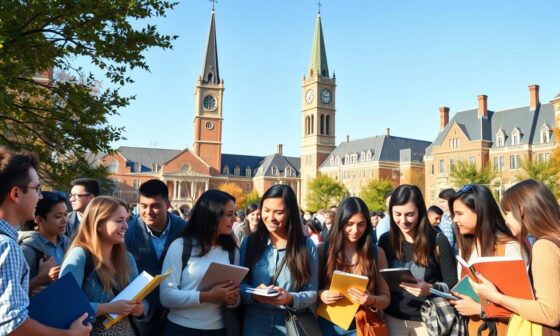Are you an aspiring international student wondering how to navigate the complex process of applying to US colleges? The journey to studying in the United States can be daunting, but with the right guidance, it can be a rewarding experience.
As an international student, you face unique challenges when applying to US colleges, from understanding the US college system to securing a student visa. This comprehensive guide is designed to walk you through each step, providing you with the necessary tools and information to make informed decisions about your educational journey.
Key Takeaways
- Understand the US college system and its requirements.
- Learn how to choose the right college for your needs.
- Discover the necessary documents for a successful application.
- Get insights into securing a student visa.
- Explore financial aid options for international students.
Understanding the US College System
The US higher education landscape is complex, with various institutions offering different academic programs and experiences. Understanding the intricacies of the US college system is essential for international students aiming to pursue higher education in America.
Types of Higher Education Institutions in the US
The US is home to a diverse range of higher education institutions, including community colleges, liberal arts colleges, public universities, private universities, and Ivy League schools. Each type of institution has its unique characteristics, academic offerings, and campus cultures.
Differences Between Public and Private Universities
Public universities are funded by state governments, making them generally more affordable for in-state students. Private universities, on the other hand, rely on tuition fees and private funding, often resulting in higher costs but also potentially more generous financial aid packages.
Understanding Liberal Arts Education
Liberal arts education focuses on providing a broad-based education in the arts, humanities, social sciences, and natural sciences. It aims to develop critical thinking, problem-solving, and communication skills, preparing students for a wide range of careers.
The US Academic Calendar and Credit System
The US academic calendar typically follows a semester or quarter system. The credit system measures the amount of academic credit earned by students for completing coursework. Understanding this system is crucial for international students to navigate their academic requirements.
| Institution Type | Characteristics | Typical Tuition Fees |
|---|---|---|
| Public Universities | State-funded, large student body | $10,000 – $20,000 per year |
| Private Universities | Private funding, often smaller classes | $30,000 – $50,000 per year |
| Liberal Arts Colleges | Focus on undergraduate education, broad curriculum | $20,000 – $40,000 per year |
Step-by-Step Guide to Applying to US Colleges as an International Student
Navigating the US college application process as an international student can be daunting, but with a step-by-step guide, you can tackle it with confidence. The process involves several critical milestones that, when understood and followed, can lead to a successful application.
12-18 Months Before: Research and Standardized Tests
The journey begins with thorough research into potential colleges and their admission requirements. It’s also crucial to prepare for and take standardized tests such as the SAT or ACT, and English proficiency tests like TOEFL or IELTS.
8-12 Months Before: Finalizing College List and Preparing Documents
After researching, create a balanced college list and start preparing necessary documents. This includes transcripts, letters of recommendation, and financial documents. Ensuring these are ready in advance streamlines the application process.
4-8 Months Before: Applications and Essays
With documents in hand, focus on completing applications and crafting compelling essays. Tailor your application materials to highlight your strengths and achievements.
After Acceptance: Visa Process and Preparation
Upon acceptance, the next step is to navigate the visa process. This involves understanding F-1 visa requirements, preparing for the visa interview, and maintaining visa status.
By following this step-by-step guide, international students can navigate the complex US college application process with ease and confidence.
Researching and Selecting the Right US Colleges
As an international student, choosing the right college in the US requires careful consideration of several factors. The US college system is diverse, with various types of institutions offering different academic programs and campus environments.
Factors to Consider When Choosing Schools
When researching US colleges, several key factors come into play. These include:
Academic Programs and Reputation
The academic programs offered by a college are crucial. Look for institutions that offer strong programs in your desired field. The reputation of the college is also important, as it can impact your future career prospects.
Location and Campus Environment
The location of a college can significantly affect your experience. Consider whether you prefer a campus in an urban, suburban, or rural setting. Additionally, think about the campus environment and the availability of resources and support services for international students.
Financial Considerations
Understanding the cost of attending a US college is vital. Tuition fees, living expenses, and the availability of scholarships or financial aid can vary significantly between institutions.
| Factor | Considerations |
|---|---|
| Academic Programs | Program strength, faculty expertise, research opportunities |
| Location | Urban vs. rural, climate, proximity to home |
| Campus Environment | Size, diversity, support services for international students |
| Financial Considerations | Tuition, living expenses, scholarships, financial aid |
Creating a Balanced College List
It’s advisable to create a balanced list of colleges that includes “reach” schools, “match” schools, and “safety” schools. This strategy can help ensure that you have multiple options when making your final decision.
Resources for International Students
Many US colleges offer resources specifically for international students, including virtual campus tours and information sessions. These resources can provide valuable insights into campus life and academic programs.
Virtual Campus Tours and Information Sessions
Utilize virtual tours and information sessions to get a feel for the campus and ask questions. These tools can help you make a more informed decision about which colleges to apply to.
Meeting Standardized Testing Requirements
Navigating the complex world of standardized testing is a critical step for international students seeking to study in the US. Understanding the various tests required and how to prepare for them is essential for meeting admission requirements.
Understanding the SAT and ACT
The SAT and ACT are two primary standardized tests used in US college admissions. While both assess a student’s readiness for college, they have different formats and scoring systems. The SAT focuses on reasoning and problem-solving skills, whereas the ACT is more content-based.
English Proficiency Tests: TOEFL, IELTS, and Duolingo
International students must also demonstrate English proficiency through tests like TOEFL, IELTS, or Duolingo. These tests assess reading, writing, listening, and speaking skills.
Test Preparation Strategies for International Students
Effective test preparation is key to achieving high scores. Strategies include familiarizing oneself with the test format, practicing with sample questions, and improving time management skills.
| Test | Purpose | Duration |
|---|---|---|
| SAT | College readiness assessment | 3 hours |
| ACT | College readiness assessment | 2 hours 55 minutes |
| TOEFL | English proficiency assessment | 4-5 hours |
Test-Optional Policies and What They Mean for You
Some US colleges have adopted test-optional policies, meaning they do not require SAT or ACT scores. However, international students should check the specific requirements for each college on their list.
Preparing Your Academic Credentials
Preparing academic credentials is essential for international students seeking to apply to US colleges. This process involves several key steps that ensure your academic achievements are properly recognized.
Transcript Evaluation and Translation
International students must provide official transcripts from their previous educational institutions. If the transcripts are not in English, they must be translated. Credential evaluation services can help with this process, ensuring that your transcripts are accurately translated and evaluated.
Understanding GPA Conversion
US colleges often require international students to convert their GPA to a US equivalent. This can be done using a GPA conversion scale or through a credential evaluation service. Understanding how your GPA converts is crucial for demonstrating your academic competitiveness.
Credential Evaluation Services
Credential evaluation services, such as WES or NCEES, evaluate your academic credentials and provide a detailed report that can be used when applying to US colleges. These services help standardize your credentials, making it easier for colleges to assess your application.
Demonstrating Academic Rigor
US colleges value academic rigor. International students can demonstrate this by taking challenging courses, such as Advanced Placement (AP) or International Baccalaureate (IB) classes, and performing well on standardized tests.
Addressing Differences in Educational Systems
The educational system in the US may differ significantly from what international students are used to. Understanding these differences and explaining them in your application can help colleges better understand your academic background.
| Service | Description | Cost |
|---|---|---|
| WES | Credential evaluation for international students | $100-$200 |
| NCEES | Credential evaluation with detailed course-by-course analysis | $150-$300 |
Crafting a Compelling Application
For international students, the journey to US colleges begins with a well-crafted application that highlights their unique strengths and experiences. A compelling application is more than just grades and test scores; it’s a comprehensive representation of who you are and what you can bring to the college community.
Understanding Common Application, Coalition Application, and University-Specific Platforms
The first step in crafting your application is understanding the different platforms available. The Common Application and Coalition Application are two popular options that allow you to apply to multiple colleges with a single application. Many US colleges also have their own university-specific platforms, so it’s essential to check the application requirements for each college on your list.

Writing Personal Statements and Supplemental Essays
Your personal statement and supplemental essays are critical components of your application. They provide an opportunity to share your story, highlighting your achievements, challenges, and goals.
Telling Your Unique International Perspective
As an international student, you bring a unique perspective to the table. Use your essays to share your cultural background, experiences, and how they have shaped your worldview. This can be a significant differentiator in the application process.
Common Mistakes to Avoid
When writing your essays, avoid common pitfalls such as generic statements, grammatical errors, and failing to answer the prompt. Have multiple people review your essays to catch any mistakes and provide feedback.
Securing Strong Letters of Recommendation
Letters of recommendation from teachers, mentors, or employers can significantly strengthen your application. Choose recommenders who know you well and can speak to your strengths and achievements.
Showcasing Extracurricular Activities and Achievements
Extracurricular activities and achievements demonstrate your passions, leadership skills, and commitment to your community. Highlight these in your application to show a well-rounded profile.
By focusing on these key areas, international students can craft a compelling application that showcases their strengths and increases their chances of being accepted into their chosen US colleges. Meeting application deadlines is also crucial, so ensure you stay organized and submit your application on time.
Navigating Financial Requirements and Scholarships
Understanding the financial aspects of studying in the US is crucial for international students. The cost of education in the US can be significant, and navigating the financial requirements is a key part of the college application process.
Understanding the Cost of US Education
The cost of studying in the US includes tuition fees, living expenses, health insurance, and other miscellaneous costs. Tuition fees vary widely between institutions, with private universities generally being more expensive than public ones. International students should research the total cost of attendance for their chosen colleges to understand the financial commitment required.
Demonstrating Financial Ability
To obtain an F-1 visa, international students must demonstrate their financial ability to support themselves during their studies. This involves showing sufficient funds to cover tuition fees and living expenses.
Required Documentation
Students need to provide financial documents as part of their visa application. These documents typically include bank statements or affidavits of support that prove their financial capability.
Bank Statements and Affidavits of Support
A bank statement should show a sufficient balance to cover the cost of education and living expenses. An affidavit of support is a legal document signed by a sponsor, stating that they will financially support the student during their studies.
Scholarships and Financial Aid for International Students
There are various scholarships and financial aid opportunities available to international students. These can significantly help in reducing the financial burden of studying in the US.
Merit-Based Scholarships
Many US colleges offer merit-based scholarships to talented international students. These scholarships are awarded based on academic excellence, talent in sports, or other achievements.
Need-Based Aid
Some institutions provide need-based financial aid to international students who demonstrate financial need. This aid can come in the form of grants, loans, or work-study programs.
Country-Specific Opportunities
Certain scholarships are available to students from specific countries or regions. International students should explore these opportunities as part of their financial planning.
Working While Studying: Regulations and Opportunities
International students on an F-1 visa have the opportunity to work part-time on campus. Understanding the regulations and opportunities for working while studying can help students manage their finances more effectively.
By carefully planning and researching financial options, international students can make their dream of studying in the USA a reality.
Securing Your Student Visa
Understanding the F-1 visa application process is essential for international students aiming to study in the US. This process involves several steps, from meeting the eligibility criteria to acing the visa interview.
Understanding F-1 Visa Requirements
To be eligible for an F-1 visa, students must be accepted into a US educational institution that is certified by the Student and Exchange Visitor Program (SEVP). They must also demonstrate sufficient financial resources to support themselves during their studies.
Preparing for the Visa Interview
Preparation is key to a successful visa interview. Students should be ready to answer questions about their academic background, reasons for choosing the US, and future plans.
Common Questions and How to Answer Them
- Why did you choose to study in the US? Highlight the unique aspects of the US education system and how it aligns with your academic goals.
- How do you plan to finance your education? Be prepared to discuss your financial plans, including scholarships, family support, or personal funds.
Required Documentation
Students should bring the following documents to their interview:
- Valid passport
- I-20 form
- SEVIS fee receipt
- Proof of financial ability
Maintaining Visa Status
Once in the US, students must maintain their F-1 status by pursuing a full course of study and adhering to the regulations set by their institution and US immigration laws.
SEVIS Fee and I-20 Form
The SEVIS fee is a mandatory payment that supports the Student and Exchange Visitor Information System. The I-20 form, issued by the educational institution, is a critical document required for the visa application.
| Document | Purpose |
|---|---|
| I-20 Form | Certificate of Eligibility for F-1 visa |
| SEVIS Fee Receipt | Proof of payment for SEVIS registration |
| Financial Documents | Proof of financial ability to support studies |

Preparing for Life in the US
To make the most of your time in the US, it’s essential to be prepared for the cultural, academic, and practical aspects of life as an international student pursuing higher education in America.
Housing Options and Considerations
Universities often provide various housing options for international students, including dormitories and shared apartments. When choosing housing, consider factors such as proximity to campus, cost, and available amenities.
Health Insurance Requirements
Most US universities require international students to have health insurance. Research the specific requirements of your institution and understand what is covered under the university’s insurance plan or consider purchasing a private plan.
Cultural Adjustment Strategies
Adjusting to a new culture can be challenging. Strategies to ease this transition include joining cultural clubs, attending international student orientation programs, and connecting with peers from similar backgrounds.
Pre-Departure Checklist
Before leaving for the US, ensure you have completed the following:
- Obtained your I-20 form and F-1 visa
- Booked your flight and arranged for airport pickup if needed
- Notified your bank and credit card company of your travel plans
- Packed essential items and important documents
Connecting with Other International Students
Connecting with other international students can greatly enhance your experience. Many universities have groups and forums for international students to share their experiences and advice.
| Aspect | Pre-Departure | Post-Arrival |
|---|---|---|
| Housing | Research university housing options | Apply for housing and complete necessary paperwork |
| Health Insurance | Research health insurance requirements | Purchase or enroll in a health insurance plan |
| Cultural Adjustment | Research cultural differences and norms | Participate in orientation programs and join cultural clubs |
Conclusion: Your Journey to US Higher Education
Embarking on the journey to US higher education as an international student can be complex, but with a clear understanding of the process, you can navigate it successfully. By following the step-by-step guide outlined in this article, you can ensure that you are well-prepared for every stage of applying to US colleges.
From understanding the US college system to securing your student visa, each step is crucial in achieving your academic goals. Researching and selecting the right colleges, meeting standardized testing requirements, and crafting a compelling application are all essential components of the application process.
As you move forward, remember that applying to US colleges is a step-by-step process that requires careful planning and preparation. By staying focused and informed, you can make your dream of studying in the US a reality.




